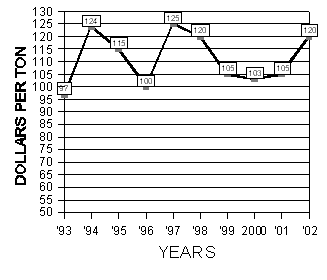Alfalfa Report
Yuma County, Arizona
March 11, 2002
Yuma County Office
2200 W. 28th Street, Ste. 102
Yuma, AZ 85364
(928) 726-3904
(928) 726-8472 FAX
Production Update:
Cutting schedules: In the low desert valleys of Arizona, cutting is recommended when most of the crown buds have started regrowth but before they are greater than 2 inches in length. Cutting at one-tenth bloom is not satisfactory under our conditions since 1) length of regrowth from crown buds in Arizona can vary from 1 to 4 inches at one-tenth bloom depending on the time of the year and 2) in late winter and early spring, alfalfa does not flower in our low desert valleys because of cool temperatures and short daylengths. If cutting is delayed and the crown regrowth is harvested, plant development is slowed since new crown growth must develop.
Insect Management: Before treating Egyptian alfalfa weevil (PDF file, 48KB) larvae with an insecticide, sample each field quadrant by taking 5 sweeps with a standard net. Count the number of weevil larvae in each 5 sweep sample and add the totals for each of the field quadrants. Divide the grand total for the field by the total number of sweeps (20). Treated with an insecticide registered for weevil control in alfalfa when the average number of larvae reaches or exceeds 20 per sweep. If sweep counts are 10 to 15 larvae per sweep just before cutting, applying malathion under the windrows may be considered.
Weed Control: Raptor is a new alfalfa herbicide that will soon be available in Arizona. It has been developed by BASF and is similar to Pursuit but more effective on sowthistle, prickly lettuce, lambsquarters and grasses. Half of the active ingredient as is applied with Pursuit is utilized and the plant-back restriction should not be as long.
| Market Summary |
High
|
Low
|
Average
|
Off grade
|
| Past 2 Weeks ( Feb 26 to Mar 11, 2002) |
125
|
105
|
120
|
90-105
|
| Last Year ( Feb 26 - Mar 11, 2001) |
115
|
100
|
105
|
70-95
|
10 Year Summary (February 26 to March 11, 1993-2002):

Issued in furtherance of Cooperative Extension work, acts of May 8 and June 30, 1914, in cooperation with the U.S. Department of Agriculture, James A. Christenson, Director Cooperative Extension, College of Agriculture and Life Sciences, The University of Arizona.
The University of Arizona is an equal opportunity, affirmative action institution. The University does not discriminate on the basis of race, color, religion, sex, national origin, age, disability, veteran status, or sexual orientation in its programs and activities.
Any products, services, or organizations that are
mentioned, shown, or indirectly implied in this web document do not imply
endorsement by The University of Arizona.
Information provided by:
Barry Tickes, btickes@ag.arizona.edu Extension Agent, Yuma County
Michael Ottman, mottman@ag.arizona.edu Agronomy Specialist
College of Agriculture, The University of Arizona.
Eric Natwick, etnatwick@ucdavis.edu UCCE Imperial County - Farm Advisor
University of California, Davis, CA.
Forages: Crop Mgmt | Soil Mgmt | Irrigation | Alfalfa Reports | Insects | Diseases | Weeds | Pesticides
Home | Other Crops | Forages
For more Arizona Production Ag Information:
Home | Cotton | Veggies| Forages | Grains | Citrus | Crop x Crop | Insects | Diseases| Weeds | Pesticides | News | Weather | Research | Photos | Contacts | General Info. | Site Map
Copyright © 2001 University of Arizona,
College of Agriculture and Life Sciences
Webmaster: Al Fournier (fournier@ag.arizona.edu)